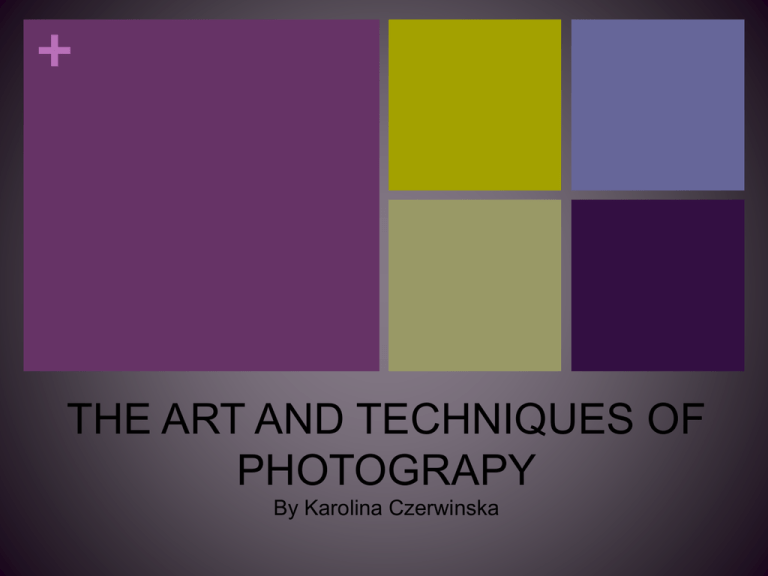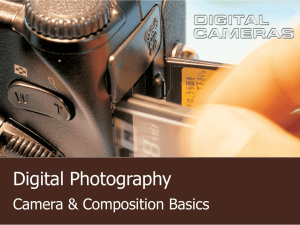Photo Angles - WordPress.com
advertisement

+ THE ART AND TECHNIQUES OF PHOTOGRAPY By Karolina Czerwinska + Photo Angles Eye Level The camera is in a straight angle with the subject of the photo opposite it. High Angle Shows the subject from above. This gives the subject a weak or insignificant appearance. Low Angle Shows the subject from below. This gives the subject a powerful appeal. Bird’s Eye This view is shot directly above the subject to create a dramatic photo. Slanted When the camera is tilted to create a dramatic effect. + CAMERA SHOTS Extremely Wide Shot- The subject is not visible in the photo because the photo is shot at such a great distance. The photo is mostly focused on the surrounding environment. Close Up- The focus of the photo is on specific part of the subject. Over the Shoulder Shot- Shows the subject from behind another person’s shoulder. + Noddy Shot- A shot of some one reacting to the subject being interviewed. Wide Shot- A photo where the entire subject can be viewed and takes up the whole frame. Weather Shot- A shot where the weather is the subject Two Shot- A photo of two people. + The Rule of Thirds is a strategies many photographers use in there photos. The photo is divided into nine separate equal; section and the photography uses this to frame the photo in an organized fashion. + Different Types of Photography One Type of photography is commercial. This kind of photos show products and advertise. An example is shown above. The ice and lemons are used to make the soda more appealing. Satellite is another form of photography that is often uses today. Theses are photos that are taken outside of the Earth’s orbit. These photos can be used to determine weather patterns. An example is shown below. Black and white photographs are personally my favorite. They enhance details and shapes. This type of photography can also make photos seem dramatic. An example is shown above. + The Six Components OF A CAMERA Body- A compartment where the film is placed. Lens- A transparent glass that focuses the light on the subject. Aperture- Controls the amount of light reaching the subject Shutter- Controls how long the light remains focused on the subject. Viewfinder- Also photographer to view the photo before it is taken. Transport- Moves the film to the correct position. Single Lens Reflex: This is the most common camera. A major component is a viewfinder that allow you to view exactly what the photo will look like. + Twin Reflex: A camera commonly used by professionals. It contains two lens. One is for the photograph and the other for the viewfinder. + Viewfinder: A very cheap camera, where the viewfinder does not depict an accurate representation of the photo. This is because the viewfinder is separate from the lens. View: A camera where the lens and the viewfinder are joined together . Pinhole: A camera without a lens. Why should you be clear about the subject? Focusing on the subject is essential in creating the perfect photograph. Having unnecessary empty space can make the photo look incomplete or awkward. However it is sometimes acceptable to include empty space if it adds to the effect of the picture. Why do you compose the entire frame, not just the subject? Composing the entire frame is important because if there is an element of the photo in the background that does that match or agree with the overall theme and composition of the photo, it can be very distracting. QUESTIONS Why use different camera angles? Using different camera angles can have a significant affect on the photograph. They can make the photo more dramatic or can fool the eyes. Different angles can make photos outstanding. Why should you strive for balance? Balance shows harmony in photos; this is a very important element. Some examples of balance are between colors, themes, textures and shapes. Why use lines when composing your composition? Different lines have different affects that make a photo appear more interesting. For example: Vertical lines show height and power. Horizontal lines show width. Diagonal lines dramatize and curved lines have a calming affect. + Questions







